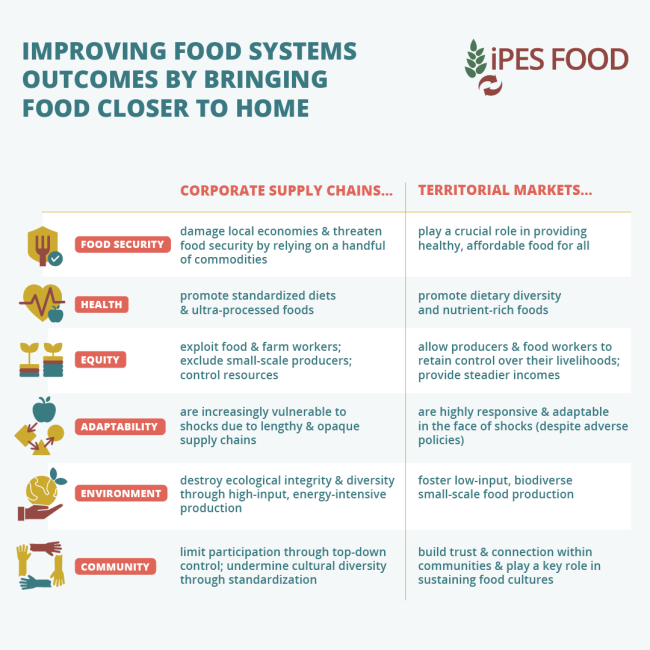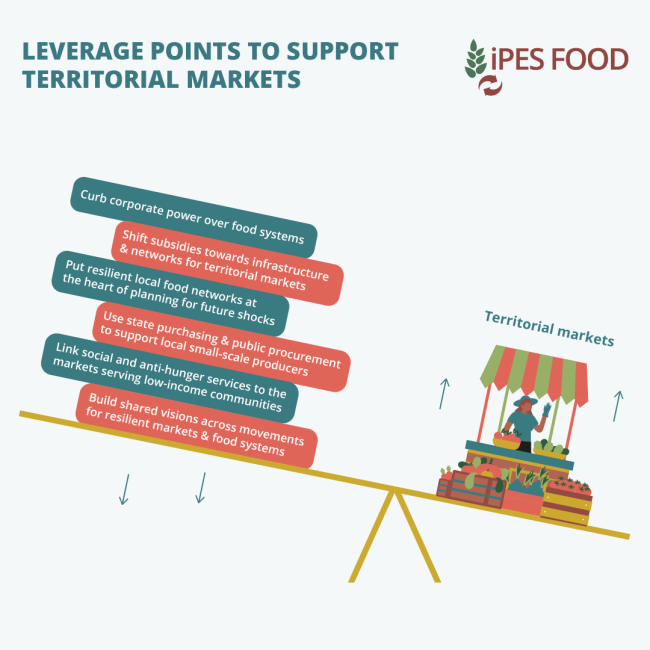The past three years have seen big cracks emerge in global commodity markets and corporate-controlled supply chains. The COVID-19 pandemic, the invasion of Ukraine, and recent climate shocks have led to supply chain chaos, lost harvests, volatile food prices, and empty shelves. Market chaos following Russia’s invasion of Ukraine caused global food prices to rise by 15%.
Dependence on just-in-time logistics, long and opaque global food supply chains, centralized shipping routes, and a handful of large corporations make global industrial supply chains catastrophically vulnerable to shocks. These supply chains also drive environmental degradation, threaten the livelihoods of small-scale producers, and undermine dietary diversity and health.
Feeding a hungry world requires resilient and robust food systems. In this comprehensive review, IPES-Food finds that a fundamental shift towards close-to-home food supply chains (‘territorial markets’) offers a more resilient, robust, and equitable approach to food security.
Importance of localized food systems
A wide variety of vibrant food provisioning systems exist beyond corporate-controlled supply chains. From public markets and street vendors to cooperatives, urban agriculture to online direct sales, food hubs to community kitchens; territorial market channels are contributing to feeding as much as 70% of the world’s population every day. They are based around small-scale producers, processors and vendors, rooted in territories and communities, and play multiple roles within them. Yet they are continuously overlooked.
Territorial markets are the backbone of food systems in many countries and regions. Evidence shows they build resilience on multiple fronts, including:
· Ensuring access to seasonal, diverse, more nutritious foods and diets. Evidence from low-income neighbourhoods in Asia, Latin America, and Africa shows that fruit and vegetables are more affordable in public markets than at supermarkets.
· Demonstrating high degrees of resilience and adaptability to shocks. Despite market closures, territorial marketing channels rapidly adapted to continue supplying food to communities through the COVID-19 pandemic – with new governance models and marketing systems. Some 45% of emergency food supply initiatives in Brazil were based on local supply chains, and over 85% were at least partly agroecological.
· Providing decent prices and steady incomes for small-scale producers, including women and youth. In Thailand, “green farmers’ markets” offer producers higher margins than big retailers and account for some 60-80% of their income.
· Enhancing environmental sustainability by promoting low-input, biodiverse farming, and reducing food miles and waste. Urban agriculture has documented benefits in terms of maintaining agro-biodiversity: urban gardeners in Quito, Ecuador, grow on average 43 different horticultural species, including heirloom varieties. Territorial markets are also the main source for diverse Indigenous seeds, particularly essential in the face of droughts.
· Sustaining traditional food cultures and fostering community connections, solidarity, and social capital. In the US, some $80 million of sales have been facilitated, and 175,000 acres of Black-owned land secured, over decades of cooperative-led organizing among Southern Black farmers.
Blockages to territorial markets
Territorial markets are delivering these benefits despite unfavourable policies and economic conditions. Government policies are propping up fragile, disaster-prone global supply chains through agricultural subsidies, trade and investment agreements, tax breaks, and food supply infrastructure skewed towards large-scale, industrial export agriculture. At the same time, corporate power continues to grow, eroding traditional practices and food cultures, co-opting local and territorial chains, and reshaping diets around staple commodities and ultra-processed foods.
Call for policy shifts to empower localized food systems to end hunger.
A change of direction is needed to address growing food insecurity and to have a chance to reach the 2030 zero hunger goal – towards close-to-home food systems that deliver resilient food security and benefit people, planet, and communities.
To unlock the full potential of territorial markets and build a more resilient food future, the IPES-Food panel identifies a series of joined-up actions for governments, including:
· Redirecting public procurement and state purchasing schemes to support sustainable small-scale producers
· Shifting subsidies to invest in the infrastructure, networks, and people that underpin territorial markets – including public marketplaces, collectives and cooperatives, rural development, training and scale-appropriate ICT.
· Protecting local markets from corporate co-optation, including breaking up supply chain monopolies and supporting inclusive governance models.
· Encouraging sustainable, biodiverse farming practices, and diverse healthy diets.


| Year of publication | |
| Geographic coverage | Global |
| Originally published | 04 Jul 2024 |
| Related organisation(s) | IPES-Food - International Panel of Experts on Sustainable Food Systems |
| Knowledge service | Metadata | Global Food and Nutrition Security | Food security and food crisesSustainable Food Systems | International marketFood marketing |
| Digital Europa Thesaurus (DET) | trade policyvegetablefruitvalue chainpublic procurement |
